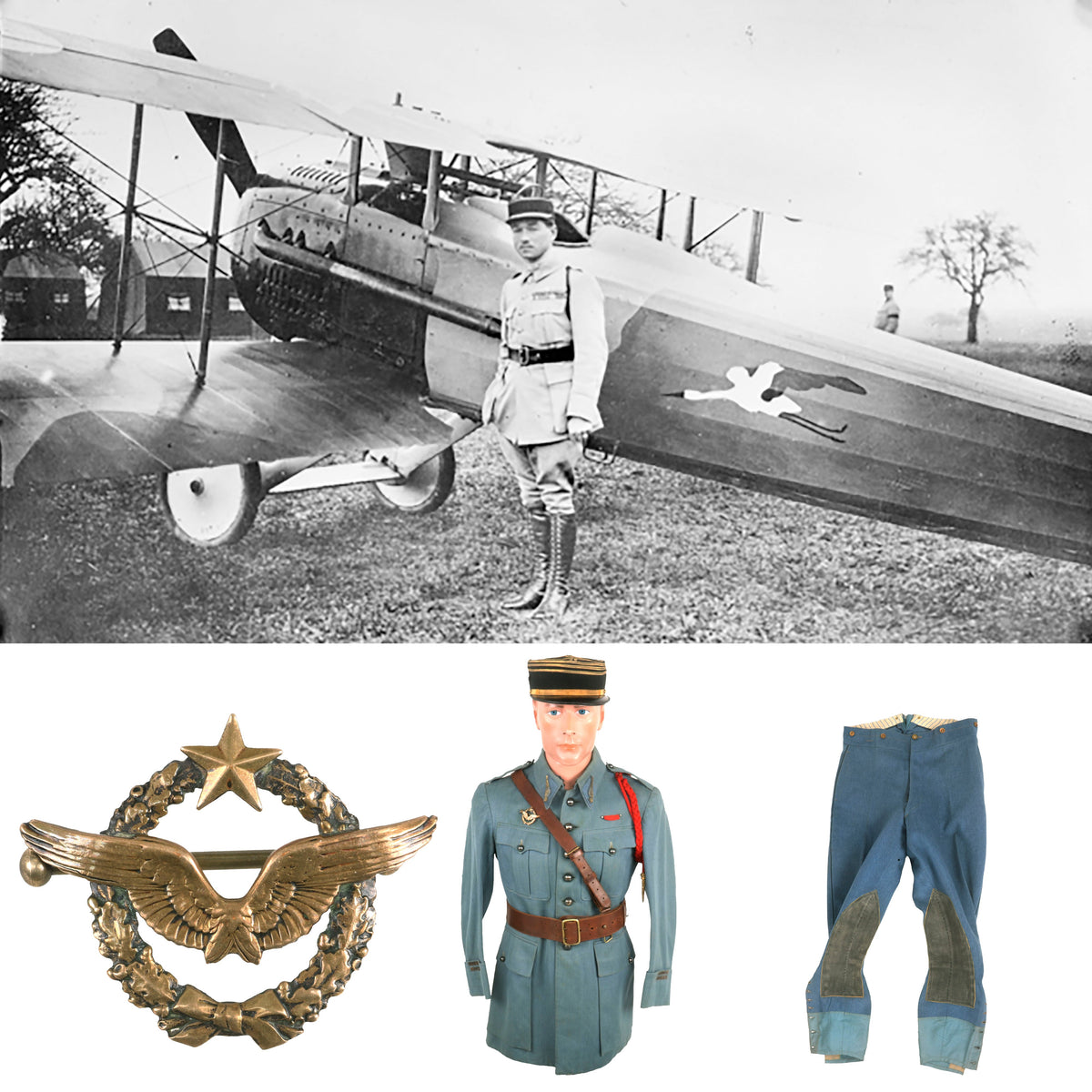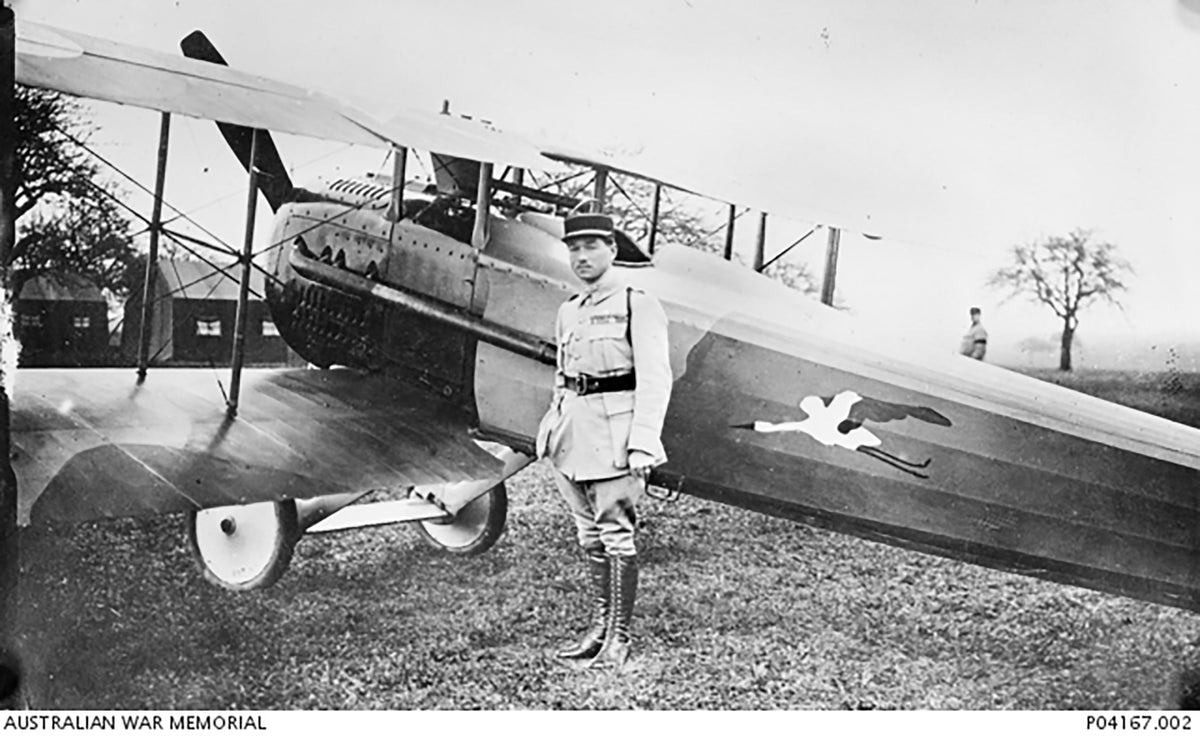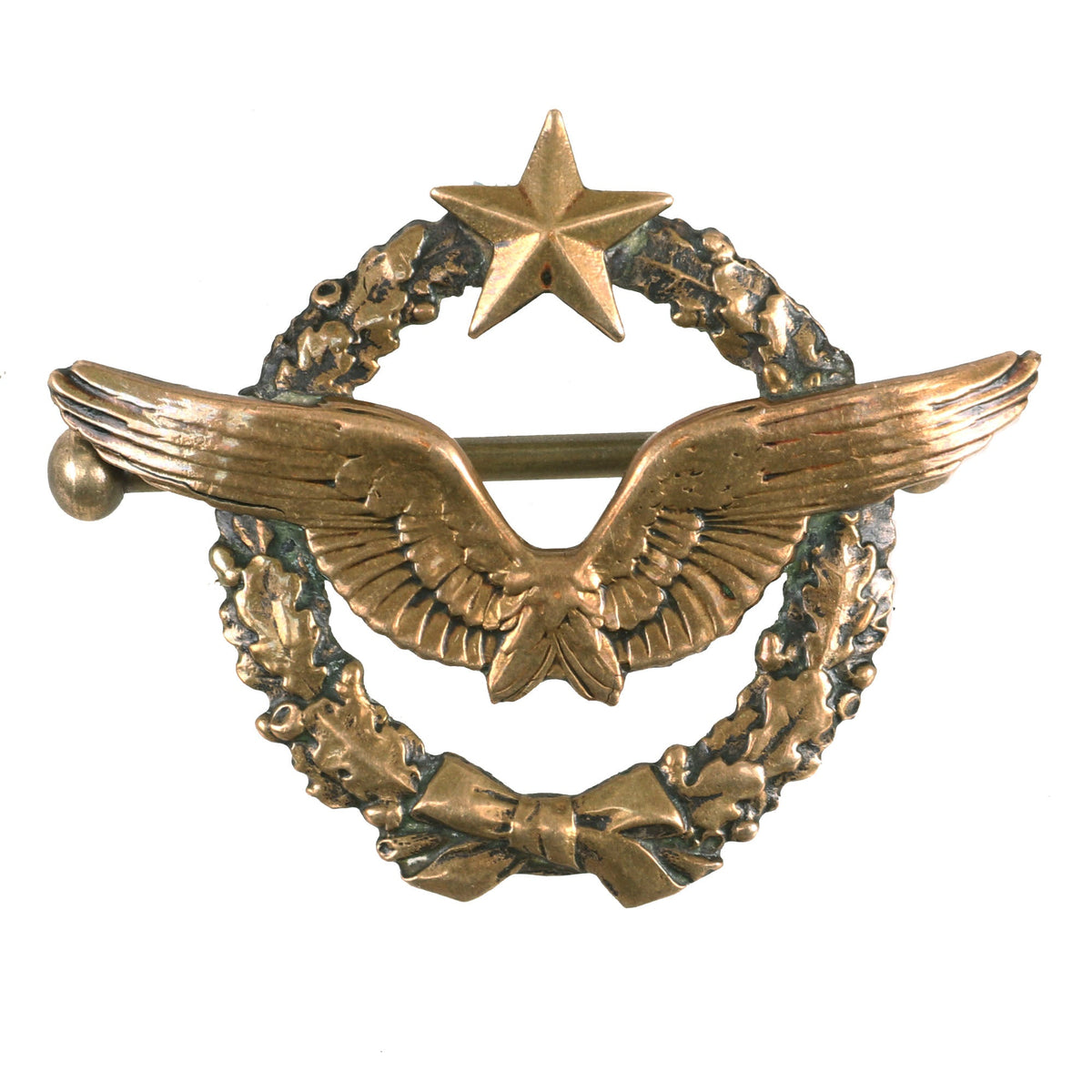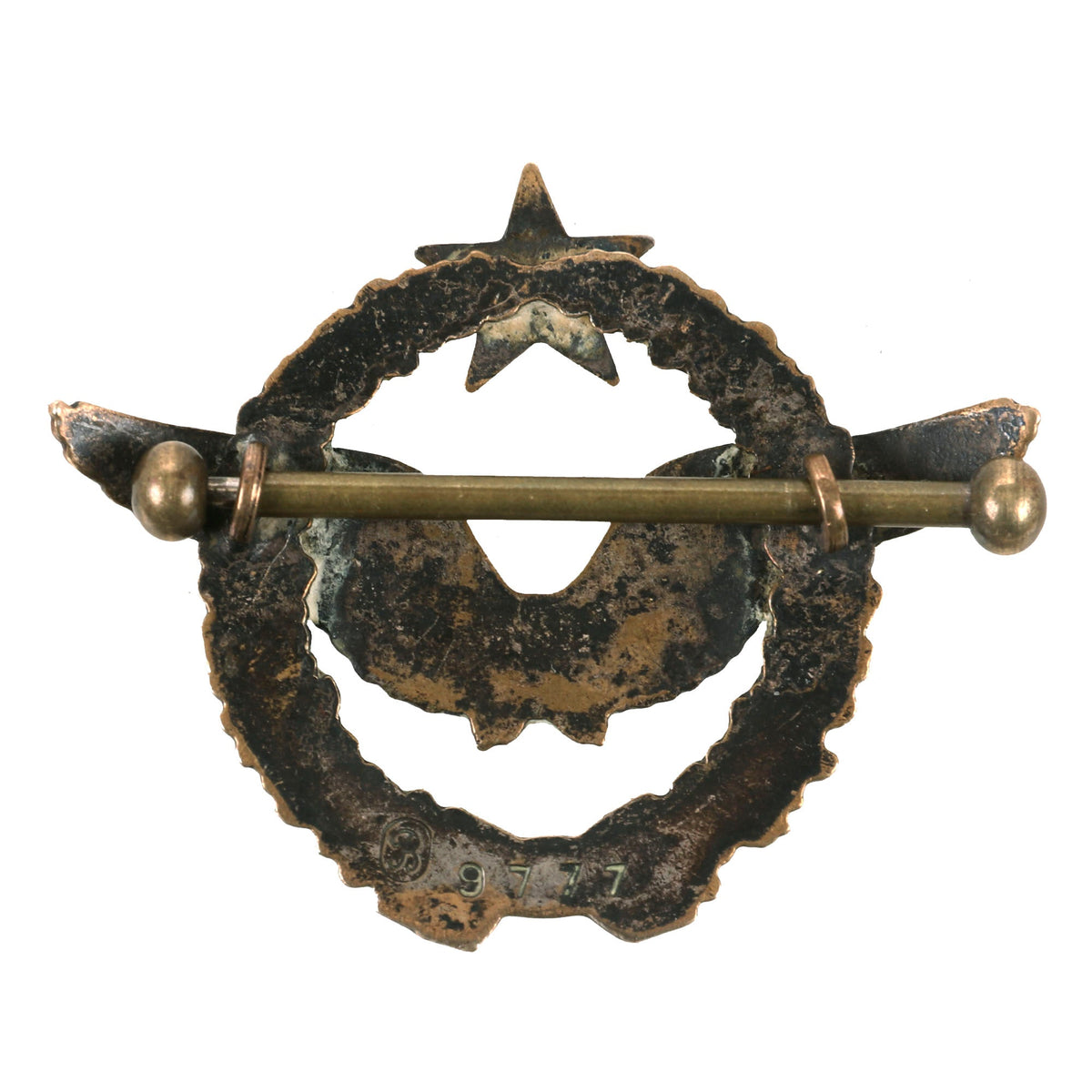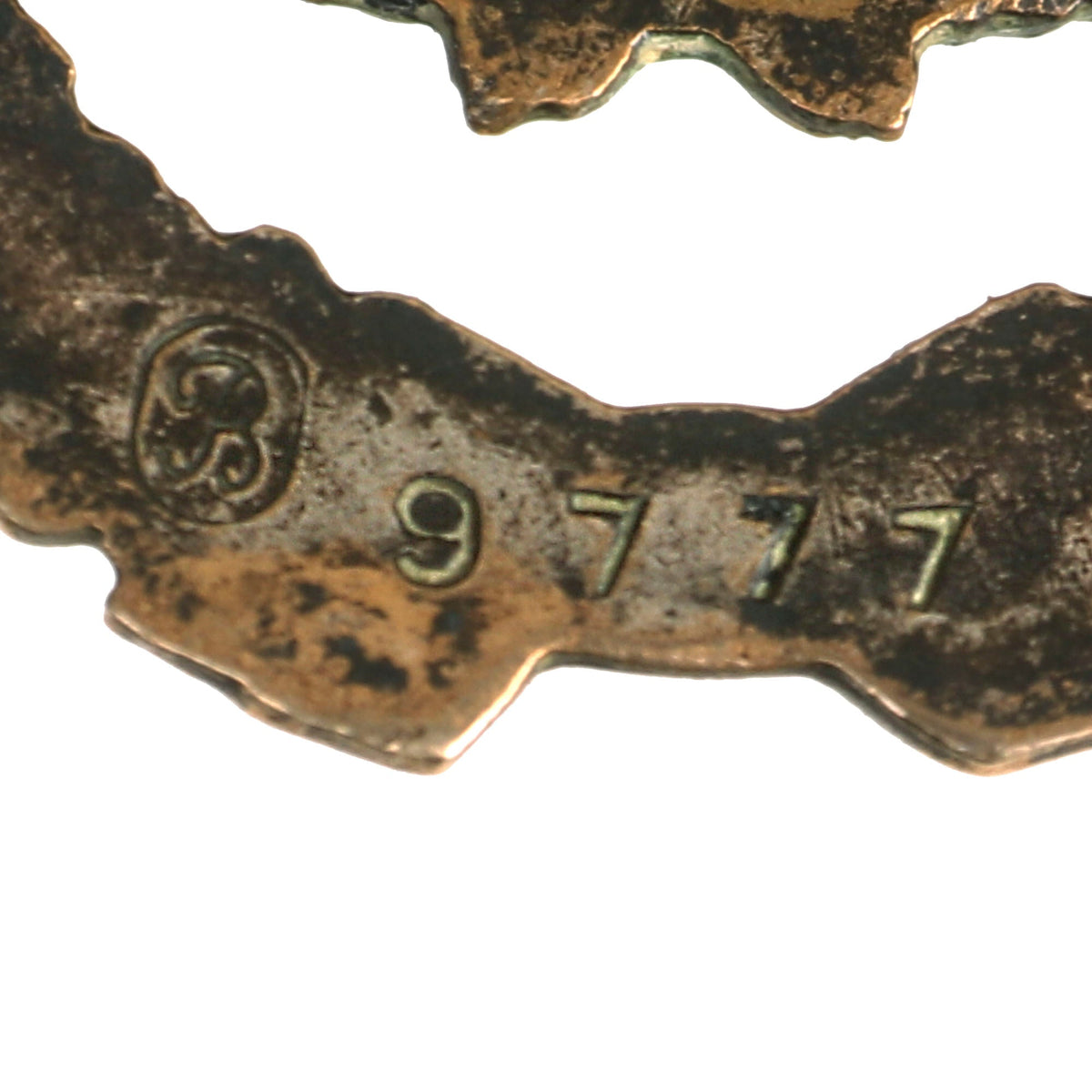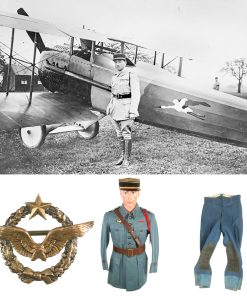Original France WWI Pilot Armée de l’Air French Air Service Officer’s Uniform Set With Tunic, Trousers, Sam Browne Belt and Kepi With Squadron Insignia – ‘Stork Escadrille N3’ Original Items
$ 3.995,00 $ 998,75
Original Items: Only One Set Available. At the start of the First World War, France led the world in aircraft design and by mid-1912 the Aéronautique Militaire had five squadrons (“escadrilles”). This had grown to 132 machines and 21 escadrilles by 1914, the same year when, on 21 February, it formally received a budget under the Ministry of War. On 3 August, Germany declared war against France.
Now this is an absolutely stunning uniform set. This was the standard issue for a WWI French Pilot. Horizon blue French Air Service service coat, single breasted with all 7 brass buttons down front. The collar tabs feature beautiful gold bullion “winged star” insignia with the color retained very well. The right side of the uniform features a lovely “B” hallmarked Pilot’s Wings Badge with the colors retained very well. The badge was issued in the final years of the war, while the “B” hallmarked badges were used up into 1925. The badge is serialized with the number 9777 indicating that it dates between 1915 to 1916. These badges in their own standpoint are very rare. The belt featured on the tunic is in wonderful condition and rests on the integrated belt hooks on the tunic quite nicely.
The kepi is a nice World War One era French Infantry Officer kepi in excellent condition. This is the lower height style kepi they first started using after phasing out the floppy or “bummer” type kepis. This style was only worn for a short time during WWI into the early 1920’s.
This example kepi is high quality and most likely a private purchase. It was issued to an officer with a bullion cross design to the crown. Interior has a leather sweatband with a black polished cotton lining. The right side of the kepi actually has an insignia identifying which squadron, a rarity in itself. The Stork insignia was adorned on the aircraft and clothing for members of Escadrille 3. The included trousers are in wonderful condition with minor moth nips present and no extensive damage.
A truly incredible set ready for further research and display.
Approximate Measurements:
Collar to shoulder: 9.5″
Shoulder to sleeve: 21”
Shoulder to shoulder: 15”
Chest width: 18″
Waist width: 17″
Hip width: 23″
Front length: 32″
Pants:
Waist: 18″
Inseam: 26″
Escadrille 3
Escadrille 3 Les Cigognes (‘The Storks’) was a famous French aviation unit during the World War I. It was often referred to as the ‘Stork Escadrille N3’ due to its insignia. Pilots from Groupe de Combat 12 adopted the name and placed images of storks in different phases of flying on their planes.
Escadrille 3 was formed in July 1912 at Avord as Escadrille B13, equipped with Bleriots. It began World War I with the Bleriots; however, on 18 March 1915, it was re-equipped with Morane-Saulnier machines and redesignated Escadrille MS3. Capitaine Felix Brocard assumed command on 28 April 1915. By 20 September, it had once again re-equipped, this time with Nieuport scouts; its new designation was Escadrille N3.
On 16 April 1916, the unit had been amalgamated into Groupement de Combat de la Somme, along with Escadrille N26, Escadrille N73, and Escadrille N103. Escadrille N37, Escadrille N62, and Escadrille N65 were also temporarily assigned to the Groupement; the seven units were placed under command of Brocard. On 16 June 1916, Capitaine Alfred Heurtaux took command of Escadrille N3. In September 1916, the Commanding General of the VI Armee commended the unit for having downed 38 enemy aircraft and three observation balloons between 18 March and 18 August 1916.
On 1 November 1916, the temporary Groupement of the four original units was formalized as Groupe de Combat 12; it became more commonly known as les Cigognes (the storks). Once again, Escadrille N3 was cited, this time by Marshal Ferdinand Foch, for scoring victories over 36 enemy aircraft between 19 August and 19 November 1916. The following March, it would be again cited, this time for downing 128 enemy machines. The escadrille subsequently re-equipped with SPADs, becoming Escadrille Spa3.
On 5 December 1918, Escadrille Spa3 was cited for the fourth time. This time it was credited with the destruction of 175 enemy aircraft, and the disabling of an additional 100. This fourth citation also entitled the escadrille to the fourragere of the Médaille militaire, and of the Croix de Guerre. The heritage of the escadrille continues in the present day French air force; it is represented by the bottom bird on the EC 1/2 Squadron emblem.
Fast Shipping with Professional Packaging
Thanks to our longstanding association with UPS FedEx DHL, and other major international carriers, we are able to provide a range of shipping options. Our warehouse staff is expertly trained and will wrap your products according to our exact and precise specifications. Prior to shipping, your goods will be thoroughly examined and securely secured. We ship to thousands clients each day across multiple countries. This shows how we're dedicated to be the largest retailer on the internet. Warehouses and distribution centres can be located throughout Europe as well as the USA.
Note: Orders with more than one item will be assigned a processing date depending on the item.
Before shipping before shipping, we'll conduct a thorough inspection of the items you have ordered. Today, the majority of orders will be delivered within 48 hours. The delivery time will be between 3-7 days.
Returns
The stock is dynamic and we cannot completely manage it because multiple stakeholders are involved, including our factory and warehouse. So the actual stock may alter at any time. It's possible that you may not receive your order once the order has been made.
Our policy is valid for a period of 30 days. If you don't receive the product within 30 days, we are not able to issue a refund or an exchange.
You can only return an item if it is unused and in the same state as the day you received it. You must have the item in its original packaging.
Related products
Uncategorized
Uncategorized
Uncategorized
Uncategorized
Uncategorized
Uncategorized
Uncategorized
Uncategorized
Uncategorized
Uncategorized
Uncategorized
Uncategorized
Band of Brothers ORIGINAL GERMAN WWII Le. F.H. 18 10.5cm ARTILLERY PIECE Original Items
Uncategorized
Uncategorized
Armored Burgonet Helmet & Polearm from Scottish Castle Leith Hall Circa 1700 Original Items
Uncategorized
Uncategorized
Uncategorized
Uncategorized
Armoured Fighting Vehicles of the World: AFVs of World War One (Hardcover Book) New Made Items
